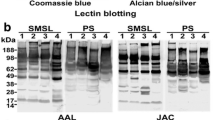Abstract
Type 1 ABO blood group antigens (peripheral core structure: Galβ1-3GlcNAcβ1-R) are expressed mainly in endodermally-derived tissues, but are not synthesized in mesodermally-derived tissues. In the former tissues, H type 1 antigen is generated largely by α-2-l-fucosyltransferase encoded by secretor (Se) gene and acting on the terminal galactose of the type 1 precursor chain. This theory has been generally accepted, and it seems that the expression of ABO blood group antigens is absent, or expressed at a low level, in these tissues from non-secretor individuals. In this immunohistochemical study on the secretory cells of salivary glands, we found ethnic difference between German and Japanese non-secretor individuals in the expression of blood group antigens: i.e. the expression of the type 1 blood group antigens is present in these cells from Japanese non-secretor individuals but absent from German. A possible explanation is that another α-2-l-fucosyltransferase, independent of the secretor gene, is present in Japanese non-secretor individuals.
Similar content being viewed by others
References
Ito N, Nishi K, Kawahara S, Okamura Y, Hirota T, Rand S, Fechner G, Brinkmann B (1990)Histochem J 22: 604–14.
Wang B, Akiyama K, Jia JT, Kimura H (1994)Forensic Sci Int 67: 1–8.
Gibbs MB, Akeroyd JH, Zapf JJ (1961)Nature 192: 1196–97.
Henry SM, Oriol R, Samuelsson BE (1994)Glycoconjugate J 11: 593–99.
Ito N, Nishi K, Nakajima M, Matsuda Y, Ishitani A, Mizumoto J, Hirota T (1986)Acta Histochem Cytochem 19: 205–18.
Ito N, Nishi K, Nakajima M, Ishitani A, Okamura Y, Matsuda Y, Hirota T (1987)J Histochem Cytochem 35: 881–90.
Nishi K, Fechner G, Rand S, Brinkmann B (1989)Z Rechtsmed 102: 255–62.
Ito N, Nishi K, Nakajima M, Okamura Y, Hirota T (1988)J Histochem Cytochem 36: 503–9.
Hakomori S (1981)Semin Hematol 18: 39–62.
Baker DA, Sugii S, Kabat EA, Ratcliffe RM, Hermentin P, Lemieux RU (1983)Biochemistry 22: 2741–50.
Breimer ME, Samuelsson BE (1986)Transplantation 42: 88–90.
Mollicone R, Dalix AM, Jacobsson A, Samuelsson BE, Gerard G, Crainic K, Caillard T, Le Pendu J, Oriol R (1988)Glycoconjugate J 5: 499–512.
Hindsgaul O, Khare DP, Bach M, Lemieux RU (1984)Can J Chem 63: 2653–58.
Henry SM, Simpson LA, Woodfield DG (1988)Hum Hered 38: 111–16.
Henry SM, Benny AG, Woodfield DG (1990)Vox Sang 58: 61–66.
Lin-Chu M, Broadberry RE, Chang FJ (1988)Transfusion 28: 350–52.
Mourant AE, Kopec A, Domaniewska-Sobczak K (1976) InThe Distribution of the Human Blood Groups and Other Polymorphisms, 2nd ed., pp. 548–76. Oxford: Oxford University Press.
Oriol R, Danilovs J, Hawkins BR (1981)Am J Hum Genet 33: 421–31.
Betteridge A, Watkins WM (1985)Glycoconjugate J 2: 61–78.
Betteridge A, Watkins WM (1985)Biochem Soc Trans 13: 1126–27.
Kumazaki T, Yoshida A (1984)Proc Natl Acad Sci USA 81: 4193–97.
Schenkel-Brunner H, Chester MA, Watkins WM (1972)Eur J Biochem 30: 269–77.
Kyprianou P, Betteridge A, Donald AS, Watkins WM (1990)Glycoconjugate J 7: 573–88.
Dabelsteen E, Vedtofte P, Hakomori SI, Young WW (1982)J Invest Dermatol 79: 3–7.
Oriol R, Le Pendu J, Mollicone R (1986)Vox Sang 51: 161–71.
Breimer ME (1984)Arch Biochem Biophys 228: 71–85.
Dabelsteen E, Graem N, Clausen H, Hakomori S (1988)Cancer Res 48: 181–87.
Blaszczyk-Thurin M, Sarnesto A, Thurin J, Hindsgaul O, Koprowski H (1988)Biochem Biophys Res Commun 151: 100–8.
Larsen RD, Ernst LK, Nair RP, Lowe JB (1990)Proc Natl Acad Sci USA 87: 6674–78.
Kelly RJ, Ernst LK, Larsen RD, Bryant JG, Robinson JS, Lowe JB (1994)Proc Natl Acad Sci USA 91: 5843–47.
Rouquier S, Lowe JB, Kelly RB, Fertitta AL, Lennon GG, Giorgi D (1995)J Biol Chem 270: 4632–39.
Kelly RB, Rouquier S, Giorgi D, Lennon GG, Lowe JB (1995)J Biol Chem 270: 4640–49.
Author information
Authors and Affiliations
Rights and permissions
About this article
Cite this article
Tanegashima, A., Nishi, K., Fukunaga, T. et al. Ethnic differences in the expression of blood group antigens in the salivary gland secretory cells from German and Japanese non-secretor individuals. Glycoconjugate J 13, 537–545 (1996). https://doi.org/10.1007/BF00731441
Received:
Revised:
Issue Date:
DOI: https://doi.org/10.1007/BF00731441




